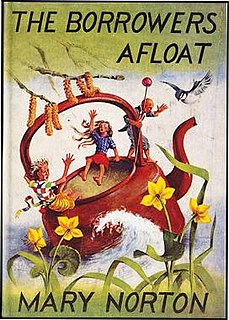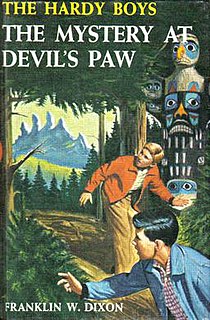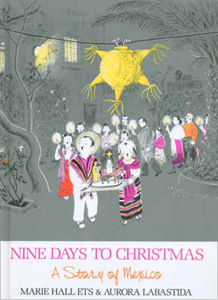 W
WThe Borrowers Afloat is a children's fantasy novel by Mary Norton, published in 1959 by Dent in the UK and Harcourt in the US. It was the third of five books in a series that is usually called The Borrowers, inaugurated by The Borrowers in 1952.
 W
WDanny Dunn and the Weather Machine is the fourth novel in the Danny Dunn series of juvenile science fiction/adventure books written by Raymond Abrashkin and Jay Williams. The book was first published in 1959 and originally illustrated by Ezra Jack Keats.
 W
WOrlovi rano lete is a Yugoslavian children's novel written by Branko Ćopić and published in 1959. It was made into a film in 1966.
 W
WEloise in Moscow is the fourth of the Eloise series of children's books written by Kay Thompson and illustrated by Hilary Knight. Published during the height of the Cold War, it details the titular rich girl's experiences in the Soviet Union.
 W
WEnd of Term is a book by British children's author Antonia Forest, published in 1959. End of Term is the fourth Marlow book, between Falconer's Lure and Peter's Room.
 W
WEngines: Man's Use of Power, from the Water Wheel to the Atomic Pile is a science book for children by L. Sprague de Camp, illustrated by Jack Coggins, published by Golden Press as part of its Golden Library of Knowledge Series in 1959. A revised edition was issued in 1961, and a paperback edition in 1969. The book has been translated into Swedish, Norwegian, Finnish, Portuguese, and German.
 W
WThe Gammage Cup is a children's book by Carol Kendall. It was first published in 1959 in the United Kingdom as The Minnipins and in the United States as The Gammage Cup. It was later republished by Scholastic in November 1991 and by Harcourt in 2000. It tells the story of a race of little people called the Minnipins who, despite inner divisions, must unite to defend their village and the valley in which they live against an evil race of humanoid creatures called the Mushrooms or Hairless Ones. The sequel, The Whisper of Glocken, was published in 1965.
 W
WHappy Birthday to You! is a 1959 children's book by Dr. Seuss, the first all-color picture book.
 W
WThe Hardy Boys Detective Handbook is a special volume in the original Hardy Boys book series published by Grosset & Dunlap.
 W
WThe Hidden Staircase is the second volume in the Nancy Drew Mystery Stories series written under the pseudonym Carolyn Keene, published in 1930 and revised in 1959. The original text was written by Mildred Wirt Benson, and she has said that it is her personal favorite of the Nancy Drew Books she wrote.
 W
WThe House On The Cliff is the second book in the original The Hardy Boys Mystery Stories published by Grosset & Dunlap. The book ranks 72nd on the Publishers Weekly's All-Time Bestselling Children's Book List in the United States with 1,712,433 copies sold as of 2001. This book is one of the "Original 10" Hardy Boys books and is an excellent example of the writing style used by the Stratemeyer Syndicate's writers. This style influenced many other "youth adventure series" books that the Stratemeyer Syndicate also published, including the Nancy Drew series, the Tom Swift adventure series, the Bobbsey Twins and other lesser known series. All of them used a unique writing style that made them very recognizable as Stratemeyer product.
 W
WHubert's Hair-Raising Adventure is the first picture book published by author Bill Peet. It features a vain lion who loses his mane in a fire, and his adventures trying to get his hair to grow back quickly. It was published in 1959 by Houghton Mifflin Co., Boston. Bill Peet wrote the book while he was still working as a storyboard artist at Walt Disney Animation Studios.
 W
WThe Lantern Bearers is a historical novel for children by Rosemary Sutcliff, first published by Oxford in 1959 with illustrations by Charles Keeping. Set in Roman Britain during the 5th century, it is the story of a British Roman's life after the final withdrawal of Roman troops. Sutcliff won the annual Carnegie Medal from the Library Association, recognising the year's best children's book by a British subject.
 W
WThe Load of Unicorn is a children's historical novel written and illustrated by Cynthia Harnett. It was first published in 1959, and then republished by Egmont Classics in 2001. It is set in London in 15th century, and concerns the adventures of an apprentice of William Caxton, the printer. The title refers to a load of paper with a unicorn watermark, ordered by Caxton from Flanders but never delivered.
 W
WMadeline and the Gypsies is a children's picture book by Ludwig Bemelmans featuring Bemelman's popular character Madeline. It was first published in 1959 by Viking Press under the Viking Juvenile imprint.
 W
WMy Side of the Mountain is a middle grade adventure novel written and illustrated by American writer Jean Craighead George published by E. P. Dutton in 1959. It features a boy who learns courage, independence, and the need for companionship while attempting to live in the Catskill Mountains of New York State. In 1960, it was one of three Newbery Medal Honor Books (runners-up) and in 1969 it was loosely adapted as a film of the same name. George continued the story in print, decades later.
 W
WThe Mystery at Devil's Paw is Volume 38 in the original The Hardy Boys Mystery Stories published by Grosset & Dunlap.
 W
WThe Mystery of the Chinese Junk is Volume 39 in the original The Hardy Boys Mystery Stories published by Grosset & Dunlap.
 W
WNine Days to Christmas is a book by Marie Hall Ets and Aurora Labastida. Released by Viking Press, it was the recipient of the Caldecott Medal for illustration in 1960.
 W
WOnion John is a novel by American writer Joseph Krumgold, published in 1959. It was the winner of the 1960 Newbery Medal. The story is set in 1950s New Jersey, and tells the story of 12-year-old Andy Rusch and his friendship with an eccentric hermit who lives on the outskirts of the small town of Serenity.
 W
WLe Petit Nicolas is a series of French children's books. It was created by René Goscinny and illustrated by Jean-Jacques Sempé and it was first published on March 30, 1959. The books depict an idealized version of childhood in 1950s France.
 W
WThe Rescuers is a British children's novel written by Margery Sharp and illustrated by Garth Williams; its first edition was published in 1959 by Collins in the United Kingdom and Little, Brown in the United States. The novel is the first in a series of stories about Miss Bianca, a socialite mouse who volunteered to lend assistance to people and animals in danger.
 W
WThe River at Green Knowe is a children's novel written by Lucy M. Boston, first published in 1959. It is part of the Green Knowe series, and is the third published in the sequence.
 W
WThe Road to Agra is a children's novel, written by Aimée Sommerfelt and published in Norwegian in 1959. It is her most famous work and has been translated into 17 other languages.
 W
WThe Secret of the Golden Pavilion is the thirty-sixth volume in the Nancy Drew Mystery Stories series. It was first published in 1959 under the pseudonym Carolyn Keene. The actual author was ghostwriter Harriet Stratemeyer Adams.
 W
WThe Secret of the Old Clock is the first volume in the Nancy Drew Mystery Stories series written under the pseudonym Carolyn Keene. It was first published on April 28, 1930, and rewritten in 1959 by Harriet Stratemeyer Adams.
 W
WThe Singing Cave is a 1959 young adult novel by Irish writer Eilís Dillon, first published by Faber & Faber in the UK. It was published the following year in the US by Funk & Wagnalls, illustrated by Stan Campbell.
 W
WThe Tower Treasure is the first volume in the original The Hardy Boys Mystery Stories published by Grosset & Dunlap. The book ranks 55th on Publishers Weekly's All-Time Bestselling Children's Book List for the United States, with 2,209,774 copies sold as of 2001. This book is one of the "Original 10", generally considered by historians and critics of children's literature to be the best examples of all the Hardy Boys, and Stratemeyer Syndicate, writing.
 W
WWhistle Down the Wind was a novella written by Mary Hayley Bell and illustrated by Owen Edwards. It was published in 1959 by Boardman and retailed for 12 shillings and sixpence (62½p). The central characters are three children — Swallow, Brat and Poor Baby. The story of the Great Secret is told by Brat.
 W
WYou Will Go To The Moon is a work of children's literature written by Mae and Ira Freeman and illustrated by Robert Patterson, published in 1959, ten years before the first moon landing. The first edition was reprinted in England in 1962 under the same title. A second edition was published in 1971, with new illustrations reflecting NASA's Project Apollo. This was reprinted in England in 1973 under the title Going to the Moon.